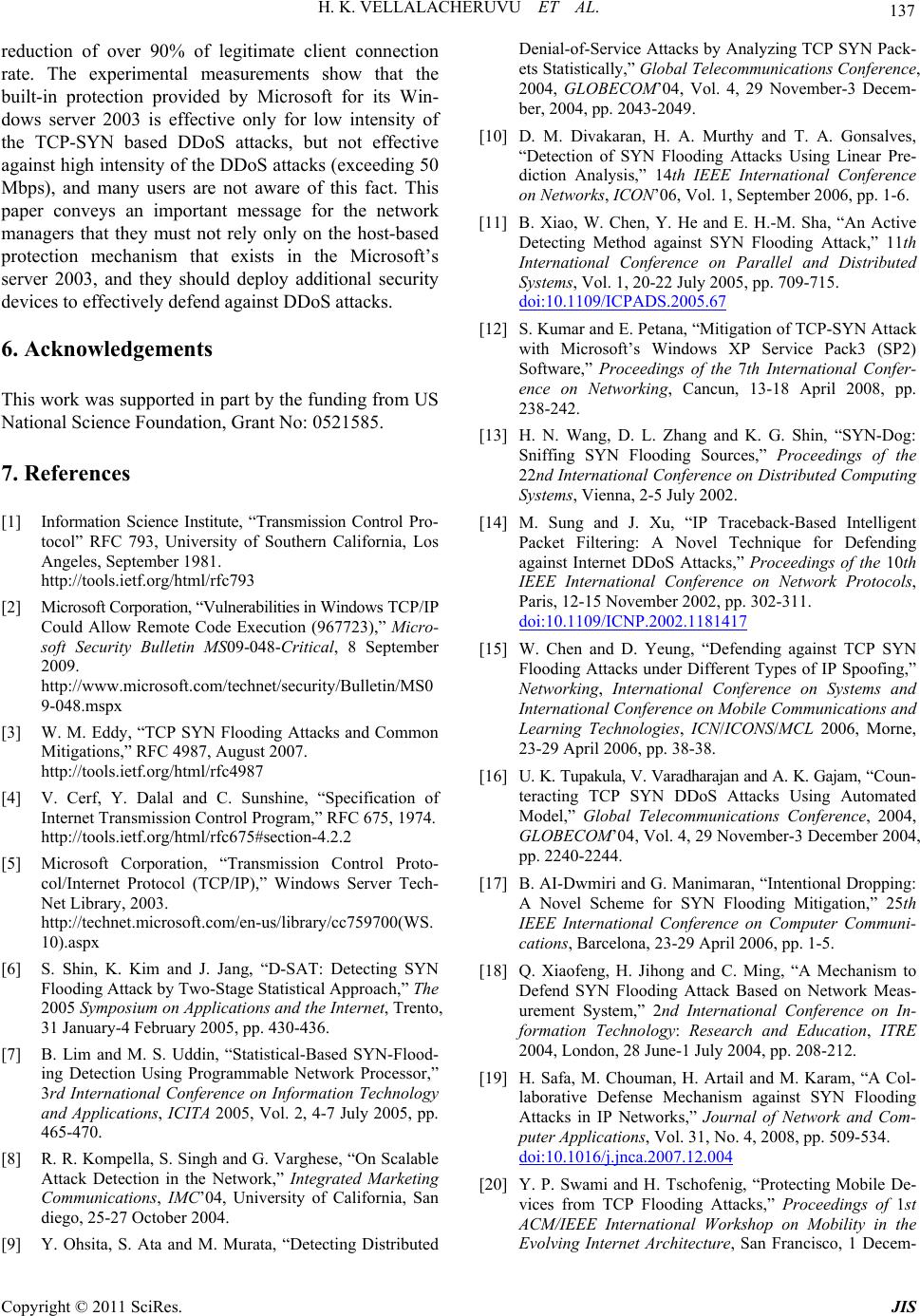
H. K. VELLALACHERUVU ET AL.
137
reduction of over 90% of legitimate client connection
rate. The experimental measurements show that the
built-in protection provided by Microsoft for its Win-
dows server 2003 is effective only for low intensity of
the TCP-SYN based DDoS attacks, but not effective
against high intensity of the DDoS attacks (exceeding 50
Mbps), and many users are not aware of this fact. This
paper conveys an important message for the network
managers that they must not rely only on the host-based
protection mechanism that exists in the Microsoft’s
server 2003, and they should deploy additional security
devices to effectively defend against DDoS attacks.
6. Acknowledgements
This work was suppo rted in part by the funding from US
National Science Foundation , G rant No: 0521585.
7. References
[1] Information Science Institute, “Transmission Control Pro-
tocol” RFC 793, University of Southern California, Los
Angeles, September 1981.
http://tools.ietf.org/html/rfc793
[2] Microsoft Corporation, “Vulnerabilities in Windows TCP/IP
Could Allow Remote Code Execution (967723),” Micro-
soft Security Bulletin MS09-048-Critical, 8 September
2009.
http://www.microsoft.com/technet/security/Bulletin/MS0
9-048.mspx
[3] W. M. Eddy, “TCP SYN Flooding Attacks and Common
Mitigations,” RFC 4987, August 2007.
http://tools.ietf.org/html/rfc4987
[4] V. Cerf, Y. Dalal and C. Sunshine, “Specification of
Internet Transmission Control Program,” RFC 675, 1974.
http://tools.ietf.org/html/rfc675#section-4.2.2
[5] Microsoft Corporation, “Transmission Control Proto-
col/Internet Protocol (TCP/IP),” Windows Server Tech-
Net Library, 2003.
http://technet.microsoft.com/en-us/library/cc759700(WS.
10).aspx
[6] S. Shin, K. Kim and J. Jang, “D-SAT: Detecting SYN
Flooding Attack by Two-Stage Statistical Approach,” The
2005 Symposium on Applications and the Internet, Trento,
31 January-4 February 2005, pp. 430-436.
[7] B. Lim and M. S. Uddin, “Statistical-Based SYN-Flood-
ing Detection Using Programmable Network Processor,”
3rd International Conference on Information Technology
and Applications, ICITA 2005, Vol. 2, 4-7 July 2005, pp.
465-470.
[8] R. R. Kompella , S. Singh and G. Varghese, “On Scalable
Attack Detection in the Network,” Integrated Marketing
Communications, IMC’04, University of California, San
diego, 25-27 October 2004.
[9] Y. Ohsita, S. Ata and M. Murata, “Detecting Distributed
Denial-of-Service Attacks by Analyzing TCP SYN Pack-
ets Statistically,” Global Telecommunications Conference,
2004, GLOBECOM’04, Vol. 4, 29 November-3 Decem-
ber, 2004, pp. 2043-2049.
[10] D. M. Divakaran, H. A. Murthy and T. A. Gonsalves,
“Detection of SYN Flooding Attacks Using Linear Pre-
diction Analysis,” 14th IEEE International Conference
on Networks, ICON’06, Vol. 1, September 2006, pp. 1-6.
[11] B. Xiao, W. Chen, Y. He and E. H.-M. Sha, “An Active
Detecting Method against SYN Flooding Attack,” 11th
International Conference on Parallel and Distributed
Systems, Vol. 1, 20-22 July 2005, pp. 709-715.
doi:10.1109/ICPADS.2005.67
[12] S. Kumar and E. Petana, “Mitigation of TCP-SYN Attack
with Microsoft’s Windows XP Service Pack3 (SP2)
Software,” Proceedings of the 7th International Confer-
ence on Networking, Cancun, 13-18 April 2008, pp.
238-242.
[13] H. N. Wang, D. L. Zhang and K. G. Shin, “SYN-Dog:
Sniffing SYN Flooding Sources,” Proceedings of the
22nd International Conference on Distributed Computing
Systems, Vienna, 2-5 July 2002.
[14] M. Sung and J. Xu, “IP Traceback-Based Intelligent
Packet Filtering: A Novel Technique for Defending
against Internet DDoS Attacks,” Proceedings of the 10th
IEEE International Conference on Network Protocols,
Paris, 12-15 November 2002, pp. 302-311.
doi:10.1109/ICNP.2002.1181417
[15] W. Chen and D. Yeung, “Defending against TCP SYN
Flooding Attacks under Different Types of IP Spoofing,”
Networking, International Conference on Systems and
International Conference on Mobile Communications and
Learning Technologies, ICN/ICONS/MCL 2006, Morne,
23-29 April 2006, pp. 38-38.
[16] U. K. Tupakula, V. Varadharajan and A. K. Gajam, “Coun-
teracting TCP SYN DDoS Attacks Using Automated
Model,” Global Telecommunications Conference, 2004,
GLOBECOM’04, Vol. 4, 29 November-3 December 2004,
pp. 2240-2244.
[17] B. AI-Dwmiri and G. Manimaran, “Intentional Dropping:
A Novel Scheme for SYN Flooding Mitigation,” 25th
IEEE International Conference on Computer Communi-
cations, Barcelona, 23-29 April 2006, pp. 1-5.
[18] Q. Xiaofeng, H. Jihong and C. Ming, “A Mechanism to
Defend SYN Flooding Attack Based on Network Meas-
urement System,” 2nd International Conference on In-
formation Technology: Research and Education, ITRE
2004, London, 28 June-1 July 2004, pp. 208-212.
[19] H. Safa, M. Chouman, H. Artail and M. Karam, “A Col-
laborative Defense Mechanism against SYN Flooding
Attacks in IP Networks,” Journal of Network and Com-
puter Applications, Vol. 31, No. 4, 2008, pp. 509-534.
doi:10.1016/j.jnca.2007.12.004
[20] Y. P. Swami and H. Tschofenig, “Protecting Mobile De-
vices from TCP Flooding Attacks,” Proceedings of 1st
ACM/IEEE International Workshop on Mobility in the
Evolving Internet Architecture, San Francisco, 1 Decem-
Copyright © 2011 SciRes. JIS